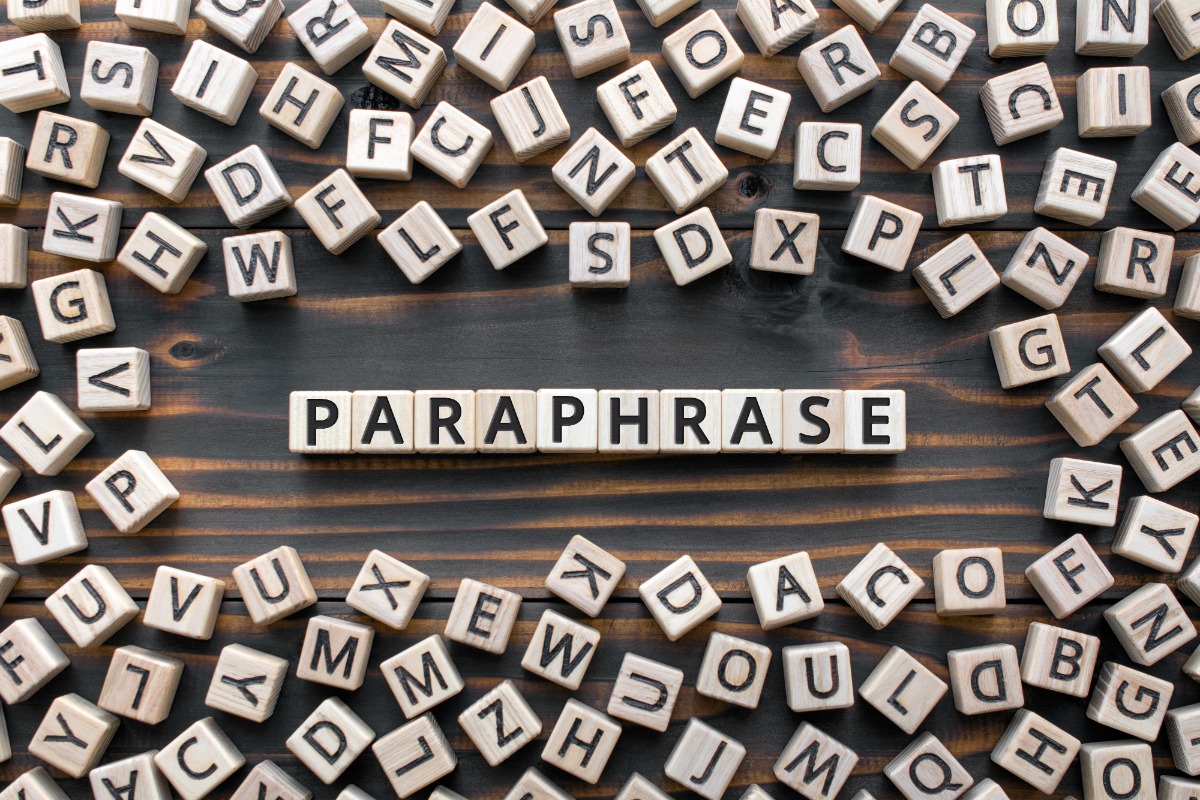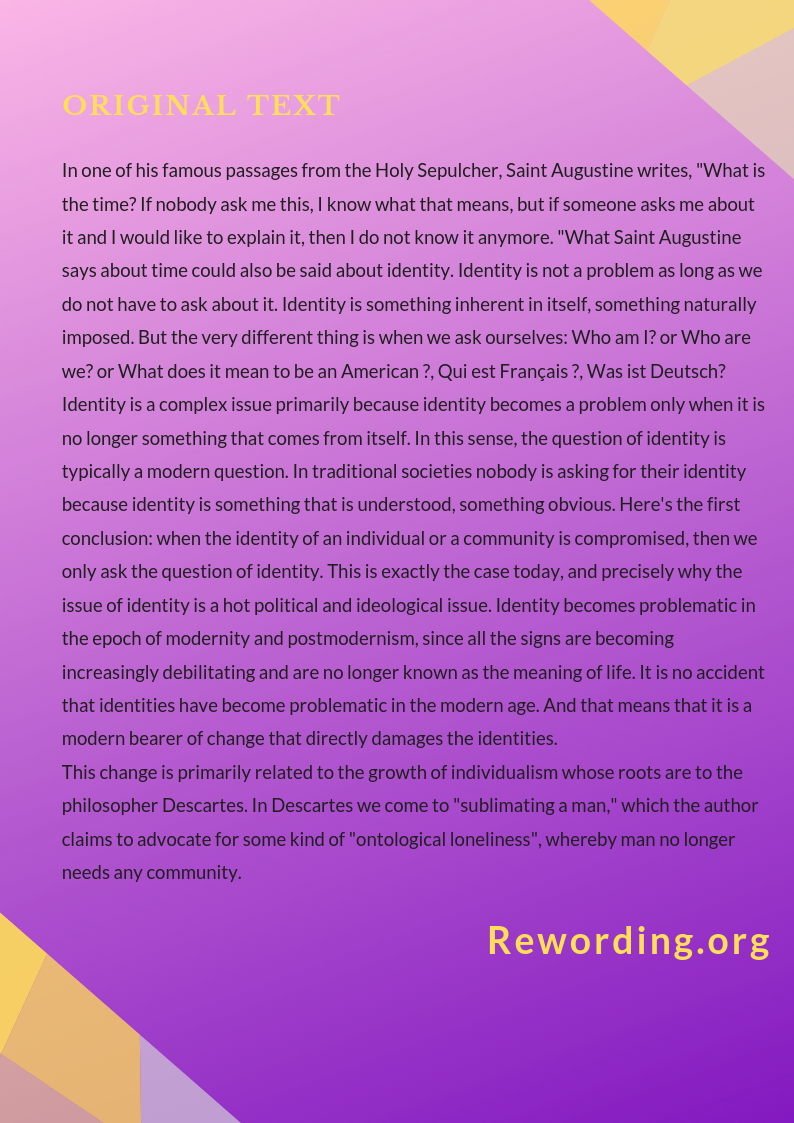Use a Paraphrasing Tool for free - your Essay Rephraser
 Paraphrasing is putting someone else's ideas into your own words, which makes the content unique. Plagiarism is using someone else’s words or ideas as if they were your own without citing the original source. To avoid plagiarism, use the essay rephraser on our college essay writing service. Instead of just changing several words in a phrase, make sure you completely reformulate the content so it's unique and original. Don’t borrow too much from other people’s essays. It will still be considered plagiarism even if you reformulate the ideas and fail to cite the source of the ideas. We advise using our paraphrasing tool for free to help you avoid any unpleasant situations with plagiarism. If you are using the exact quotes, or phrases from a source, make sure you enclose the original content in quotation marks and link to the original source. Using other resources can certainly increase the credibility of your essay, but only if you cite the sources correctly.
Paraphrasing is putting someone else's ideas into your own words, which makes the content unique. Plagiarism is using someone else’s words or ideas as if they were your own without citing the original source. To avoid plagiarism, use the essay rephraser on our college essay writing service. Instead of just changing several words in a phrase, make sure you completely reformulate the content so it's unique and original. Don’t borrow too much from other people’s essays. It will still be considered plagiarism even if you reformulate the ideas and fail to cite the source of the ideas. We advise using our paraphrasing tool for free to help you avoid any unpleasant situations with plagiarism. If you are using the exact quotes, or phrases from a source, make sure you enclose the original content in quotation marks and link to the original source. Using other resources can certainly increase the credibility of your essay, but only if you cite the sources correctly.
It just leaves out a few words. Remember, a paraphrase must provide the same information as the original and be written in your own word choice and sentence structure. Correct: As stated in Heat magazine, Miley Cyrus has a number of bizarre rules for dating. She’s so specific about what her dates wear, say, and do, that she has her assistant enforce these rules on dates. Cyrus doesn’t even like flowers and won’t let her dates buy them for her (“These Are Miley Cyrus’ Crazy Dating Rules”). Original source: “Often, a dog will chase an animal with the focus of a heat-seeking missile. But a wheelbarrow planter was not part of Belgian sheepdog Rider’s focus. Rider collided with the wheelbarrow while the squirrel escaped up a cedar tree in Joyce Biethan’s backyard. “He’s kind of an all-or-nothing dog and he went into ‘all,'” Biethan said. His collision left Rider with a broken scapula, a broken rib and a punctured lung. “He was in so much pain that I think he just tried to lay low,” Biethan said.
You want to use it to support your own arguments, after all. And that’s why you need to incorporate any paraphrased content with a specific consideration. Begin by clearly identifying the purpose of the paraphrased material in your argument. It should provide support, evidence, or a contrasting perspective to your points. Use only relevant paraphrased information that directly supports your thesis or main points. To maintain the focus on your argument, avoid over-reliance on paraphrased content; instead, use it consciously to improve your analysis and move it forward. It can be a smart decision to use AI reword paraphraser to streamline the process. After presenting the paraphrased material, offer your interpretation or critique to demonstrate its significance to your argument. This not only shows your understanding of the source but also how it aligns with or challenges your perspective. In the end, properly cite anything that you rephrase in APA or any other required format, attributing the original idea to its source while maintaining the flow of your writing.
 Given an odd number of inputs, the first vector is forwarded as-is to the next level of recursion. The autoencoder is trained to reproduce every vector in the full recursion tree, including the initial word embeddings. 4 and 3 respectively, the autoencoders would produce 7 and 5 vector representations including the initial word embeddings. The output is then normalized to have mean 0 and standard deviation 1 and is fed into a fully connected layer with a softmax output. The dynamic pooling to softmax model is trained using pairs of known paraphrases. Skip-thought vectors are an attempt to create a vector representation of the semantic meaning of a sentence, similarly to the skip gram model. Skip-thought vectors are produced through the use of a skip-thought model which consists of three key components, an encoder and two decoders. Given a corpus of documents, the skip-thought model is trained to take a sentence as input and encode it into a skip-thought vector. The skip-thought vector is used as input for both decoders; one attempts to reproduce the previous sentence and the other the following sentence in its entirety.
Given an odd number of inputs, the first vector is forwarded as-is to the next level of recursion. The autoencoder is trained to reproduce every vector in the full recursion tree, including the initial word embeddings. 4 and 3 respectively, the autoencoders would produce 7 and 5 vector representations including the initial word embeddings. The output is then normalized to have mean 0 and standard deviation 1 and is fed into a fully connected layer with a softmax output. The dynamic pooling to softmax model is trained using pairs of known paraphrases. Skip-thought vectors are an attempt to create a vector representation of the semantic meaning of a sentence, similarly to the skip gram model. Skip-thought vectors are produced through the use of a skip-thought model which consists of three key components, an encoder and two decoders. Given a corpus of documents, the skip-thought model is trained to take a sentence as input and encode it into a skip-thought vector. The skip-thought vector is used as input for both decoders; one attempts to reproduce the previous sentence and the other the following sentence in its entirety.
In other words, no new sentences are formed. Rather, the existing ones are used. There was a banana on the shelf. Jeff looked at the banana on the shelf. He then asked the shopkeeper the price of the banana. Then, he picked up the banana. He then bought the banana. He then ate the banana. There was a banana on the shelf. He then bought the banana. He then ate the banana. So, coming back to the point, depending on which type of summarizing you’re trying to do, the whole process could either be very simple and short or it could be long and complex. For example, if you are writing an extractive summary, then you will just need to scan the content once and then pick out the most meaningful sentences from the lot. On the other hand, if you are writing an abstractive summary, then you will need to read the content through and then use your own words to convey the main concept.